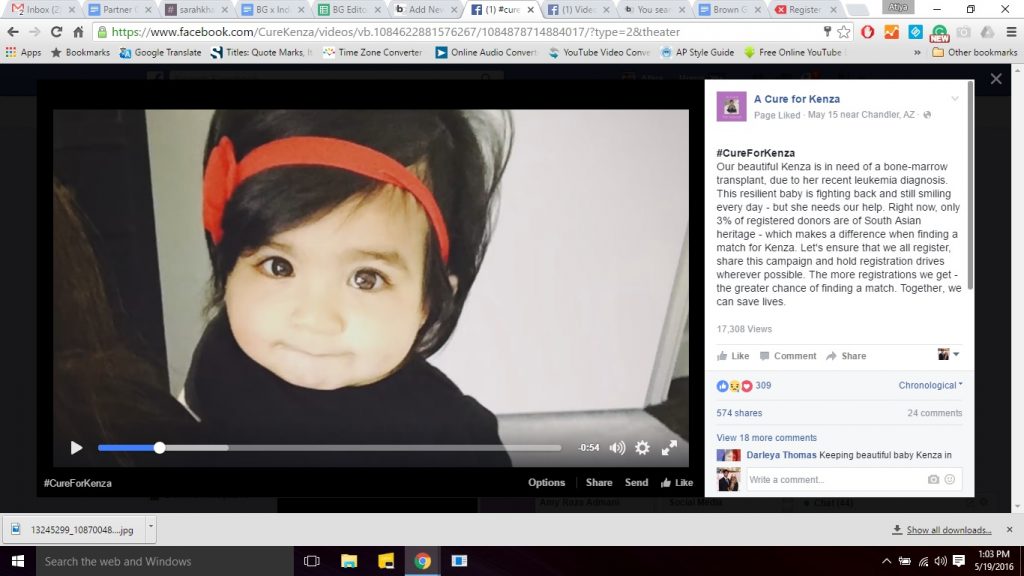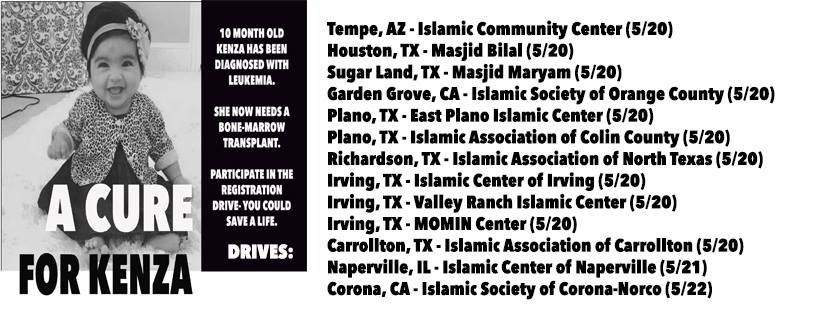
by BG Staff
Cancer. The one word you never want to hear from your physician’s mouth. The one word you never want to hear from your friends’ or family’s mouths. The one word that has the ability to uproot entire lives, families, and communities.
As we speak, 10-month-old Kenza is struggling with the diagnosis of cancer — leukemia to be more specific. The entire Dallas-Fort Worth South Asian community has rallied their efforts to help find her a match. Baby Kenza’s story is slowly reaching all parts of the US. And it’s important that this happens. Baby Kenza has about six weeks to find a bone marrow match so she is able to undergo a transplant. After which, her options become further limited. Unfortunately, only about three percent of the existing registry has South Asians on it, the closest possibility of being a match with Baby Kenza. To increase Baby Kenza’s odds of having a chance at life, we need to change these numbers dramatically.
The staff at Brown Girl was discussing the heart-wrenching story of Baby Kenza and, slowly, stories of how cancer has touched each of our lives started coming out. It wasn’t long before we realized that, in some shape or form, cancer had affected each one of us.
Below, we share some of these stories with you, so you can join us in helping Baby Kenza and the thousands of others like her who live with the bleak hope of finding a match. Let’s change these dire odds, and become the beacon of hope for someone else.
Read to the bottom to find out how you can help.
Before I was born, my sister was diagnosed with brain cancer. My family moved to America, leaving everything and everyone they knew behind just so they could help my sister. The surgery left my sister blind, weak, and overall with the mind of a 10 year old. Her brain cancer returned again when I was in middle school. I can’t get into all the details of what we went through, but I think the important part here is that Kenza can be cured. If there was a cure for my sister, we would have done everything and more to help. We can help Kenza now. – Sarah Khan
My heroic grandmother suffered with cancer for over 40 years. She was a true inspiration. She would, despite her intense pain, wake up at four in the morning daily to pray, meditate, and still found enough energy to feed my grandfather. She passed away two years ago, and her memory will live forever in my mind.
My mother was also diagnosed with cancer a year ago, and with a round of chemotherapy, she is now in remission. I would be nothing without my mother or my grandmother, because they are some of the strongest women I know. – Shanthi Guruswamy
My grandmother on my dad’s side had stomach cancer and passed away way before I was born, so I’ve felt the emptiness of not having a full set of grandparents since birth. One of my aunts was diagnosed with breast cancer last year and is thankfully now in remission, but the struggles she has endured and the pain she is still in sometimes is apparent and hard to stomach, even through our weekly FaceTime calls. I can only hope a day comes when no one in the world has to hear the words “you have cancer.” – T.
When I was in college, a classmate’s cousin was diagnosed with leukemia and didn’t have a match for a bone marrow transplant. We (as well as her family members across the country) held bone marrow donor registration drives at school to encourage more South Asians to register. Our drives were incredibly successful in a short amount of time and actually inspired the formation of an organization dedicated to registering more students at our university. Though the classmate’s cousin sadly ended up passing away, I’m still hearing stories of students who match with and donate to complete strangers because they registered at our drives. It’s an incredible way to help someone, and especially important for minorities since we’re so underrepresented in the national registry. Registering while you’re young is important too (younger donors provide the greatest chance for a successful transplant) so don’t delay! – Meghana Kaloji
I was recently notified by the National Marrow Donor Program’s Be The Match Registry that I am a preliminary marrow match for a 16-year-old girl. When I joined the registry my sophomore year of college, I never thought I could potentially save a life one day. It’s still so surreal to think I am capable of making a life-changing difference in one person’s life, whom I may never meet or learn more about.
It’s no surprise, South Asian Americans are smart, funny, and are becoming more of a well-rounded community, but there’s one thing holding us back—the significantly low number of possible donor registrants. The truth is, bone marrow donation is simple, safe and a relatively painless process but the lack of understanding about this process is the biggest reason South Asian patients have a difficult time finding a suitable match. It’s important to note, about three-fourths of bone marrow donations, are non-surgical procedures, and unlike donating organs, bone marrow and stem cells grow back after donation.
I look forward to sharing my journey during this procedure via BrownGirlMagazine.com, and hope you will join me in becoming a donor today and saving a life tomorrow. – Trisha Sakhuja
Bone marrow is important because it is where all blood cells begin their journey. Having a malfunctioning bone marrow causes a lot of the blood-related cancers like leukemia.
Getting on the registry is a very simple process. Simply visit deletebloodcancer.org and register. Registration requires you to answer a few quick questions about yourself and your health, they will then mail you a cheek swab kit and instructions with a paid return envelope. The entire process is painless and free.
Listed below are some of the places that will be holding in-person bone marrow drives this weekend. If you will be in the area for any, take your friends and family and participate!  Follow Baby Kenza’s journey to being cured at the Facebook page run by her close family: A Cure For Kenza.
Follow Baby Kenza’s journey to being cured at the Facebook page run by her close family: A Cure For Kenza.
We hope you will join the Brown Girl staff in fighting cancer. Comment below and let us know how cancer has touched your life, if you have been able to get on the registry or share pictures of your cheek swab kit. We’d love to be involved in the process because, together, we can increase the odds for everyone.




